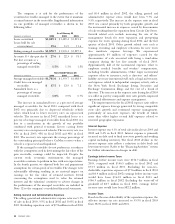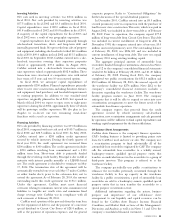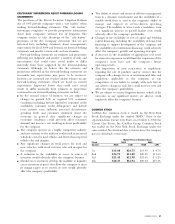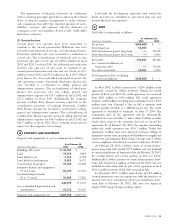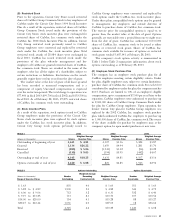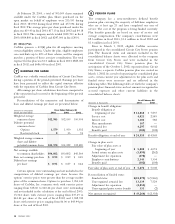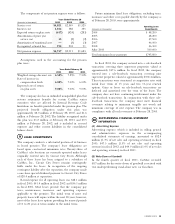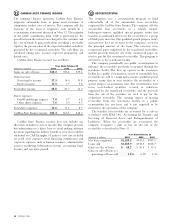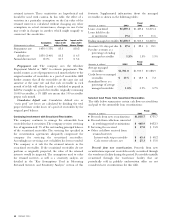CarMax 2003 Annual Report Download - page 34
Download and view the complete annual report
Please find page 34 of the 2003 CarMax annual report below. You can navigate through the pages in the report by either clicking on the pages listed below, or by using the keyword search tool below to find specific information within the annual report.
32 CARMAX 2003
BACKGROUND AND BASIS OF PRESENTATION
CarMax, Inc. and its wholly owned subsidiaries (“CarMax,”
“CarMax, Inc.” and “the company”) is the leading specialty
retailer of used cars and light trucks in the United States.
Circuit City Stores, Inc. (“Circuit City Stores” or “former
parent”) established the CarMax used vehicle business in
1993 to revolutionize the highly fragmented used vehicle
retail market. CarMax was the first used vehicle retailer to
offer a large selection of quality used vehicles at low, “no-
haggle” prices using a customer-friendly sales process in an
attractive, modern sales facility. CarMax also sells new
vehicles under franchise agreements with DaimlerChrysler,
Mitsubishi, Nissan, Toyota, Ford and General Motors.
CarMax provides its customers with a full range of related
services, including the financing of vehicle purchases
through its own finance operation, CarMax Auto Finance
(“CAF”), and third-party lenders, the sale of extended
warranties and vehicle repair service.
On September 10, 2002, Circuit City Stores shareholders,
which included Circuit City Stores, Inc.-Circuit City Group
Common Stock shareholders and Circuit City Stores, Inc.-
CarMax Group Common Stock shareholders, approved the
separation of the CarMax business from Circuit City Stores,
and the Circuit City Stores board of directors authorized the
redemption of the CarMax Group Common Stock and the
distribution of CarMax, Inc. common stock to effect the
separation. The separation was effective October 1, 2002.
Each outstanding share of CarMax Group Common Stock
was redeemed in exchange for one share of new CarMax,
Inc. common stock. In addition, each holder of Circuit City
Group Common Stock received, as a tax-free distribution, a
0.313879 share of CarMax, Inc. common stock for each share
of Circuit City Group Common Stock owned as of
September 16, 2002, the record date of the distribution. As a
result of the separation, all of the businesses, assets and
liabilities of the CarMax Group are now held in CarMax,
Inc., an independent, separately traded public company.These
consolidated financial statements are presented as if CarMax
existed as an entity separate from the other businesses of
Circuit City Stores during the periods presented.
Circuit City Stores contributed to CarMax all of the
subsidiaries and net assets and liabilities that constituted the
CarMax Group. CarMax includes the same businesses, assets
and liabilities whose financial performance was intended to be
reflected by the CarMax Group Common Stock. CarMax’s
assets and liabilities are accounted for at the historical values
carried by Circuit City Stores prior to the separation.
In conjunction with the separation, all outstanding
CarMax Group stock options and restricted stock were
replaced with CarMax, Inc. stock options and restricted
stock with the same terms and conditions, exercise prices
and restrictions as the CarMax Group stock options and
restricted stock they replaced.
The current relationship between Circuit City Stores and
CarMax is governed by a transition services agreement,
under which Circuit City Stores provides CarMax certain
services including human resources, payroll, benefits
administration, tax services, computer center support and
telecommunications services. These services have terms
ranging from six to 24 months, with varying renewal
options. A tax allocation agreement, which generally
provides that pre-separation taxes attributable to the business
of each party will be borne solely by that party, was also
executed upon separation.
SUMMARY OF SIGNIFICANT ACCOUNTING
POLICIES
(A) Principles of Consolidation
The consolidated financial statements include the accounts
of CarMax and its wholly owned subsidiaries. All significant
intercompany balances and transactions have been
eliminated in consolidation.
(B) Cash and Cash Equivalents
Cash equivalents of $29.6 million at February 28, 2003, consist
of highly liquid debt securities with original maturities of three
months or less. Included in cash equivalents at February 28,
2003, is a restricted cash deposit of $11.5 million associated
with certain insurance deductibles. There were no cash
equivalents at February 28, 2002.
(C) Securitizations
The company uses a securitization program to fund
substantially all of the automobile loan receivables originated
by CAF. The company sells the automobile loan receivables
to a wholly owned, bankruptcy-remote, qualified special
purpose entity that transfers an undivided interest in the
receivables to a group of third-party investors.This program
is referred to as the warehouse facility.
The company periodically uses public securitizations to
refinance the receivables previously securitized through the
warehouse facility to free up capacity in the warehouse
facility. In a public securitization, a pool of automobile loan
receivables are sold to a bankruptcy-remote, qualified
special purpose entity that in turn transfers the receivables
to a special purpose securitization trust.
The transfers of receivables are accounted for as sales in
accordance with Statement of Financial Accounting
Standards (“SFAS”) No. 140, “Accounting for Transfers and
Servicing of Financial Assets and Extinguishments of
Liabilities.” The company retains various interests in the
automobile loan receivables that it securitizes. The retained
interests, presented on the company’s consolidated balance
sheets, include the present value of the expected residual
cash flows generated by the securitized receivables, the
restricted cash on deposit in various reserve accounts and an
NOTES TO CONSOLIDATED FINANCIAL STATEMENTS
2
1


